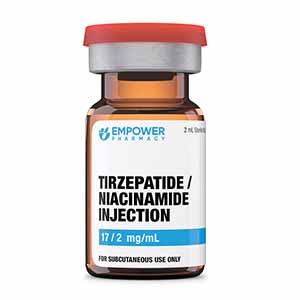About Tirzepatide
Tirzepatide injection functions as a dual GLP-1 and GIP agonist. Similar to other GLP-1 medicines, it is currently used as a second-line diabetic treatment and administered as a once-weekly subcutaneous injection.
Tirzepatide is a glucose-dependent insulinotropic polypeptide (GIP) receptor and glucagon-like peptide-1 (GLP-1) receptor agonist. It has not been tested on individuals with pancreatitis and is not approved to treat type-1 diabetes mellitus. As a GIP and GLP-1 receptor agonist, it is implemented as a second-line defense against type 2 diabetes for glycemic control and significantly reduces body weight.
According to recent clinical studies, tirzepatide decreases hemoglobin A1C levels more effectively than a placebo. In comparison to -0.86% with placebo, the SURPASS-5 clinical trial revealed a -2.11% drop in hemoglobin A1C levels at 5mg per week dose. Hemoglobin A1C decreased by -2.34% when tirzepatide was taken at the maximum dose of 15 mg per week. This was proven during a 40-week period. With a tirzepatide dosage of 5 mg, a weight loss of 5.4 kg was observed, while a weight loss of 10.5 kg was observed with a dosage of 15 mg. A popular GLP-1 drug used for weight loss therapy is similar to this dose-dependent link with weight loss.
Tirzepatide has been demonstrated to function similarly to GLP-1 medicines but more effectively. Given its ability to help people lose weight and absence of liver toxicity, it could help people with non-alcoholic fatty liver disease (NAFLD) in a secondary way.
Dosage Strength
Tirzepatide / Niacinamide Injection (2 mL Vial)
Tirzepatide / Niacinamide Injection (2.5 mL Vial)
Tirzepatide / Niacinamide Injection (4 mL Vial)
Tirzepatide causes thyroid C-cell tumors in rats. It is unknown whether Tirzepatide causes thyroid C-cell tumors, including medullary thyroid carcinoma (MTC), in humans as the human relevance of tirzepatide-induced rodent thyroid C-cell tumors has not been determined.
Tirzepatide is contraindicated in patients with a personal or family history of MTC or in patients with Multiple Endocrine Neoplasia syndrome type 2 (MEN 2). Counsel patients regarding the potential risk of MTC and symptoms of thyroid tumors.
Patients with Hepatic Impairment: No dosage adjustment of tirzepatide is suggested for patients with hepatic impairment.
Patients with Renal Impairment: Tirzepatide is associated with gastrointestinal ADRs, including nausea, vomiting, and diarrhea leading to dehydration, which can cause acute kidney injury. Use with caution in patients prone to dehydration.
Adverse reaction & Side effects
Most users of the product report minimal adverse reactions, primarily gastrointestinal issues. Common side effects include decreased appetite, nausea, diarrhea (up to 10% of users), and occasional vomiting or acid reflux. Constipation has also been noted. It’s important to mention that delayed stomach emptying may hinder the absorption of other oral medications, including hormonal contraceptives, leading to reduced effectiveness. In some cases, sinus tachycardia can be managed with other medications.








